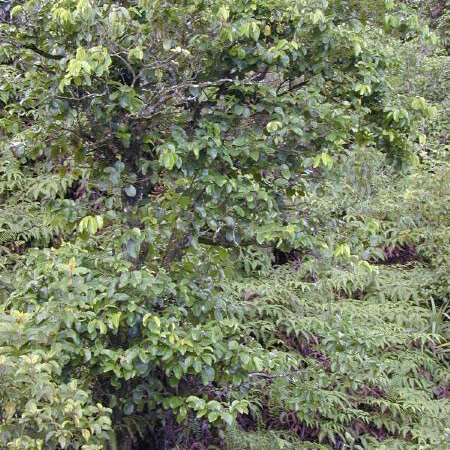Dioecious shrubs or small trees with a simple indumentum. Leaves alternate, shortly petiolate, stipulate, simple, entire, penninerved, usually brochidodromous, provided with acarodomatia, eglandular. Inflorescences axillary, leaf-opposed, terminal or cauliflorous, shortly pedunculate, simple or compoundly spicate or racemose, solitary or subfasciculate, usually densely flowered; bracts small, 1-flowered. Male flowers: calyx ± cupular, 3–5(–8)-toothed or-lobed, the lobes imbricate; petals 0; disc-glands free or ± connate, extrastaminal or covering the receptacle; stamens (2–)3–5(–10), episepalous, filaments free, long-exserted, arising from within or from among the disc-glands, anthers inflexed in bud, apicifixed, bilobate, thecae ± divergent, almost free, basally dehiscent, connective thick; pistillode small, often ± cylindric. Female flowers: calyx ± as in ♂; disc hypogynous, annular or cupular; ovary 1(–2)-locular, with 2 apical pendulous anatropous ovules per locule; styles (2–)3(–5), very short, usually bilobed, terminal or lateral. Fruit a small, often oblique and compressed-ellipsoid red or black indehiscent drupe; endocarp hardened, laxly reticulate-foveolate. Seed solitary by abortion (very rarely 2 developed), ecarunculate; albumen fleshy; cotyledons broad, flat.
Trees or erect shrubs, dioecious; indumentum of simple hairs. Leaves alternate, eglandular; stipules small; petiole usually short; leaf blade simple, margin entire, venation pinnate. Inflorescences axillary, sometimes apparently terminal, or cauline, spikes or racemes, sometimes much branched. Male flowers: calyx 3-5(-8)-lobed, cup-shaped, lobes imbricate; petals absent; disk extrastaminal, annular or cushion-shaped (enclosing bases of stamens and pistillode), or consisting of free lobes; stamens (1-)3-5(-7), inserted inside/within disk or sinus of disk lobes, incurved in bud, afterward straight; filaments longer than sepals; anthers 2-locular, connectives U-shaped; thecae separate from each other, resembling swollen ends of U, raised at anthesis, dehiscing longitudinally; pistillode usually present. Female flowers: sepals as in male; disk annular surrounding ovary, entire; ovary longer than sepals, usually 1-locular; ovules 2 per locule, pendent; styles 2-4, short, terminal to lateral, apex usually bifid. Fruit a drupe, ovoid, ellipsoid, or lens-shaped, with many areoles when dry, crowned with persistent styles, usually 1-seeded. Seeds small, endosperm fleshy, cotyledon flattened and broad. x = 13.
Male flowers: calyx 3–5(8)-lobed, lobes imbricate; petals absent; disk extrastaminal, the glands free or connate; stamens (2)3–5(10), opposite the sepals; filaments free, exserted; anthers inflexed in bud, later erect, apicifixed, connective thick, thecae distinct, divergent, basally and longitudinally dehiscent; pistillode small, often cylindric, sometimes absent.
Female flowers: calyx as in the male; petals absent; disk hypogynous, annular or cupular; ovary 1(2)-locular, with 2 pendulous ovules per locule; styles (2)3(5), very short, united at the base, terminal or lateral, usually 2-lobed, often persistent.
Leaves alternate, shortly petiolate, stipulate, simple, entire, penninerved and usually brochidodromous, acarodomatiiferous, eglandular; stipules entire and deciduous (or laciniate and persistent, but not so in Flora Zambesiaca area).
Inflorescences axillary, leaf-opposed, terminal or cauliflorous, solitary or few-fascicled, spicate, racemose or subpaniculate, shortly pedunculate, densely flowered; bracts small, 1-flowered; flowers small, sessile or subsessile.
Fruit drupaceous, unilocular, small, often oblique, laterally compressed, indehiscent, often red or black; mesocarp fleshy; endocarp hardened, reticulate-foveolate.
Seeds 1(2) per fruit, ecarunculate; albumen fleshy, not copious; cotyledons broad, flat.
Dioecious trees or shrubs with a simple indumentum.

